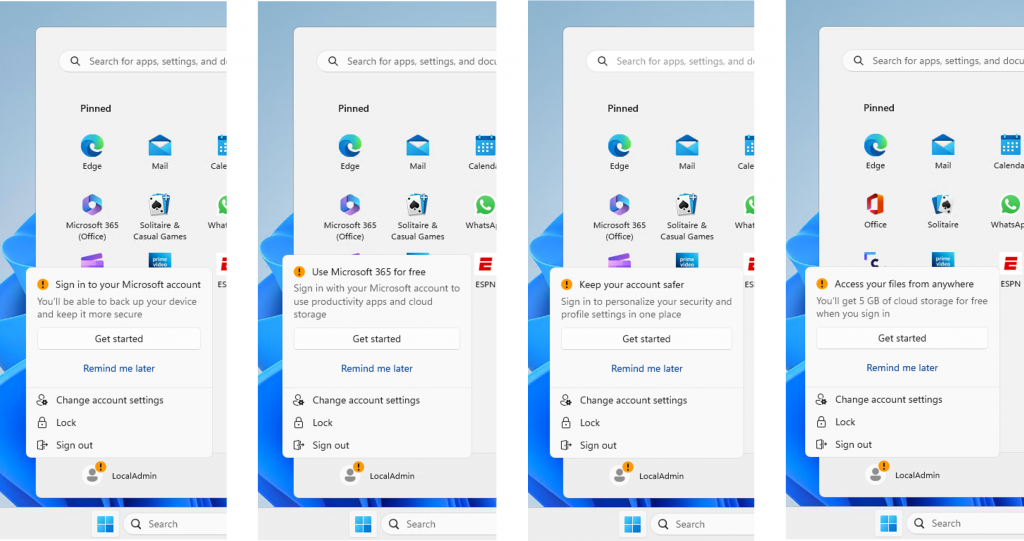If you have read the blog post about the latest Windows 11 Dev build, you may have noticed the following paragraph: "We are continuing the exploration of badging on the Start menu with several new treatments for users logging in with local user accounts to highlight the benefits of signing in with a Microsoft account (MSA). If you see one of these treatments, give us feedback on what you think:" (via Ask Woody)
Microsoft refers to the Start Menu advertisement for using a Microsoft Account, which it started to show to users of Insider builds of Windows 11. Microsoft started to experiment with OneDrive notifications in the Start Menu in late 2022 already, and has modified the messages since then. One of the latest iterations displayed an error icon to local account users to increase the pressure further.
One could say now that this is one of the risks associated with running development builds of the Windows operating system. Microsoft is going to try things to see how they do, and will remove some before the launch of the next stable version of the operating system.
Microsoft is motivated to convince users to use a Microsoft account. In doing so, it gains access to data and also options to sell some of its products to users. Several recent feature additions are clearly aimed at that.
The Settings app highlights OneDrive storage now and Outlook users may have discovered recently that they can't send or receive emails anymore, as Microsoft decided to add Outlook file attachments to the customer's storage quota. Microsoft experimented with ads in File Explorer, and with promotional messages elsewhere.
The company is quick when it comes to introducing these promotional messages in Windows, but often not as quick when it comes to giving users a choice to disable those messages.
Windows 11 has several preferences already that determine whether some of the promotional messages are displayed or not. There is the notorious System > Notifications > Additional Settings > Get tips and suggestions when using Windows setting, or the dreaded "Show the Windows welcome experience after updates and when signed in to show what's new and suggested".
Many Windows customers and testers have turned these off, either manually or by using privacy tools, but there is no centralized setting that deals with everything. The Start Menu promotions, for instance, require a new Setting, which does not exist yet.
Another annoyance: when users complete the initial steps of setup after installation of the operating system, they will notice that they can't create a local account easily anymore. Microsoft removed the option from Home and Pro systems. While there are options to create a local account on Windows still, most customers are unaware of these and will create a Microsoft Account instead, as they have no option to proceed otherwise.
There is also Out of Box Experience dialog, which Microsoft introduced in Windows 10. It asks customers to select country and keyboard settings, create the first account, make some privacy changes, and the Welcome Experience, which promotes certain Microsoft products. The latter includes no option to decline, only to postpone. If postponed, it will be displayed over and over again to the user, unless the option is turned off in the Settings app.
Closing Words
Regardless of Stable or Beta versions of Windows, Microsoft should give its customers straightforward options to turn off undesirable features in the operating system. These need to be attached to the dialogs, windows or badges directly, and should not be hidden somewhere deep in the Settings or missing.
Microsoft should not have an "anything goes" approach in development builds, and it should start valuing its Home customers more again.
Or, as Susan Bradley over at Ask Woody puts it, "Sometimes we WANT the choice we have gone OUT OF OUR WAY to select. If we wanted a Microsoft account, we would get that Microsoft account.".
Now You: what would you change in Windows, if you had the might to do so?
Thank you for being a Ghacks reader. The post Please Microsoft, stop these Evil Empire tactics in Windows appeared first on gHacks Technology News.

0 Commentaires